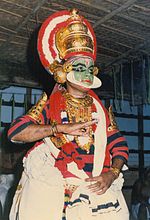Koodiyattam
This article includes a list of references, related reading, or external links, but its sources remain unclear because it lacks inline citations. |

Koodiyattam or Kutiyattam (IPA: [kuːʈijaːʈːam]) is a form of theatre traditionally performed in the state of Kerala, India. Performed in the Sanskrit language in Hindu temples, it is believed to be at least two thousand years old. It is officially recognised by UNESCO as a Masterpiece of the Oral and Intangible Heritage of Humanity.
Origin
Kulasekhara Varma Cheraman Perumal, an ancient king of Kerala, is known as the creator of Koodiyattam in the present form, and his Aattaprakaram is considered the most authoritative publication on the art form.
Performance style


Traditionally, Koodiyattam has been performed by Chakyars (a subcaste of Kerala Hindus) and by Nangyaramma (women of the Ambalavasi Nambiar caste). The name Koodiyattam (meaning "playing together") suggests a combined performance of Chakyar and Nangyar. The main actor is a Chakyar who performs the ritualistic Koothu and Koodiyattam inside the temple or in the Koothambalam. Chakyar women, Illotammas, are not allowed to participate. Instead, the female roles are played by Nangyaramma.
Traditionally, the main musical instrument used in Koodiyattam is the Mizhavu, a percussion instrument which is played by a person of the Nambiar caste, accompanied by Nangyaramma playing the kuzhithalam (a type of cymbal). However, recently the Edakka, another traditional drum, has also been used as accompaniment.
Famous artists


In the modern world, the late Natyacharya Vidushakaratnam Padmasree guru Mani Madhava Chakyar has been the best-known face of Koodiyattam. He was known for mastery of Rasa Abhinaya with special reference to Netrābhinaya. He has been a major force in popularizing Koodiyattam by taking it out of the Hindu temples, performing across India with his troupe, and teaching it to non-Chakyar caste members. He has also adapted, choreographed and directed well-known plays such as Kalidasa's The Recognition of Sakuntala, Vikramorvaśīya and Mālavikāgnimitra; Bhasa's Swapnavāsadatta and Pancharātra for performance in the Koodiyattam style.
His disciple and nephew Mani Damodara Chakyar is also a renowned Koodiyattam performer, who is an exponent of traditional devotional Koodiyattams, such as Anguliyanka, Mattavilasa Prahasana, Mantranka, Ezhamanka (seventh act of Ascharyachoodamani).
Related literature and books
- The Nātya Shāstra, an ancient work of dramatic theory Bharata Muni describes the Sanskrit theatre of the Gupta Empire; Koodiyattam is believed to preserve some aspects of the performance style of that period.
- Abhinaya darpana by Nandikeshvara,another work of dramatic theory comparable to the Nātya Shāstra.
- Natyakalpadruma (1975), a Kerala Sahitya Academy Award-winning book on Koodiyattam written by Guru Mani Madhava Chakyar, considered authoritative by scholars.[citation needed]
References


See also
- Mani Madhava Chakyar
- Mani Damodara Chakyar
- Natyakalpadrumam
- Arts of Kerala
- Koothu
- Kathakali
- Mohiniyattam
- Thulall
- Bharata Muni
- Nandikeshvara
External links
- Data Bank on Traditional performances of Sangeet Natak Academy, New Delhi
- Kutiyattam
- more on the subject
- Kutiyattam - Sanskrit Theater of India (Multimedia CD) by Dr.Farley Richmond
- Cyberkerala Koodiyattam Page
- Mykerala Koodiyattam Page
